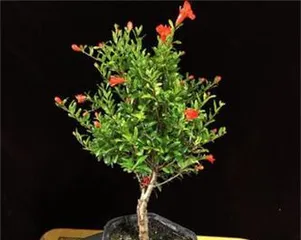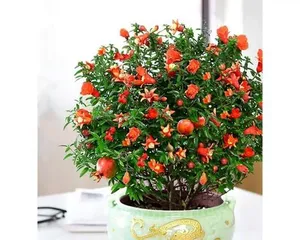Indoor gardening is a popular method of interior decoration. Some people believe that growing flowers is a task that requires a lot of energy and time, but pomegranate flowers are a relatively easy plant to care for. In this article, we will introduce the reasons why pomegranate flowers are suitable for indoor cultivation, and how to care for this beautiful perennial plant.

I. Understanding Pomegranate Flowers
Pomegranate flowers (Punica granatum), belonging to the Lythraceae family, are native to Iran and Turkey. They are typically evergreen shrubs or small trees, growing to a height of 1.5-5 meters. There are many varieties of pomegranate flowers, including different colored flowers such as red, pink, white, and yellow.
II. Why are pomegranate flowers suitable for indoor cultivation?
Although pomegranate flowers are native to the warm Mediterranean region, they can also adapt to indoor living conditions. Pomegranate flowers prefer warm, abundant sunlight, and moist soil, conditions that can also be provided indoors. Pomegranate flowers also do not require a lot of fertilization and maintenance, and they can grow and flower in moderate temperatures.

III. Varieties of Pomegranate Flowers
Common varieties of pomegranate flowers include Dahonghua, Zhusha, Shuangchong Fanhua, etc. These varieties differ in color, flower shape, and other aspects, but their care methods are largely the same.
IV. How to choose the right variety of pomegranate flowers?
When choosing pomegranate flowers, consider factors such as their maturity time, flowering period, and color. In addition, choose healthy plants and check for any signs of pests or diseases.
V. How to provide sufficient sunlight for pomegranate flowers?
Pomegranate flowers need plenty of sunlight to grow and bloom. Indoors, choose a window or balcony that can receive direct sunlight, and ensure it gets at least 6 hours of sunlight per day.

VI. How to provide suitable soil for pomegranate flowers?
Pomegranate flowers need moist but not overly wet soil. Use a mixture containing leaf mold and perlite to plant pomegranate flowers. Additionally, apply a moderate amount of organic fertilizer in the spring each year.
VII. How to water?
Pomegranate flowers need frequent watering to keep the soil moist. However, be careful not to overwater, as this can lead to root rot. In the summer, water once or twice a week, and reduce to once a week in the winter.
VIII. How to prune?
To maintain the health and shape of the pomegranate flowers, pruning should be done regularly. In the spring, cut back overlong or diseased branches, and provide support for flower stalks and new shoots.
IX. How to control pests and diseases?
Pomegranate flowers are susceptible to pests such as aphids, whiteflies, and borers. If pests are found, insect sprays or natural control methods can be used to solve the problem.
X. How to propagate pomegranate flowers?
Pomegranate flowers can be propagated by seeds, cuttings, or division. Seeds need a warm environment to germinate, cuttings require healthy branches, and division involves separating mature plants.
XI. How to deal with fallen petals?
The petals of pomegranate flowers fall off easily. Fallen petals should be cleaned up regularly to keep the flowers looking beautiful.
XII. How to deal with the lodging of pomegranate flowers?
When pomegranate flowers grow too tall or the branches become too long, they are prone to lodging. At this time, support should be provided in a timely manner to avoid affecting the growth and appearance of the pomegranate flowers.
XIII. How to top-dress the soil?
Every spring, a new layer of soil should be added, and a layer of organic fertilizer should be applied to the surface to maintain soil moisture and fertility.
XIV. How to provide enough air for pomegranate flowers?
Pomegranate flowers need sufficient air circulation to stay healthy. Indoors, you can open windows or use an air purifier to provide enough fresh air.
XV.
Pomegranate flowers are a beautiful perennial plant, suitable for indoor cultivation. By understanding the varieties, care techniques, and propagation methods of pomegranate flowers, you can become an expert and enjoy the beauty and surprises they bring.